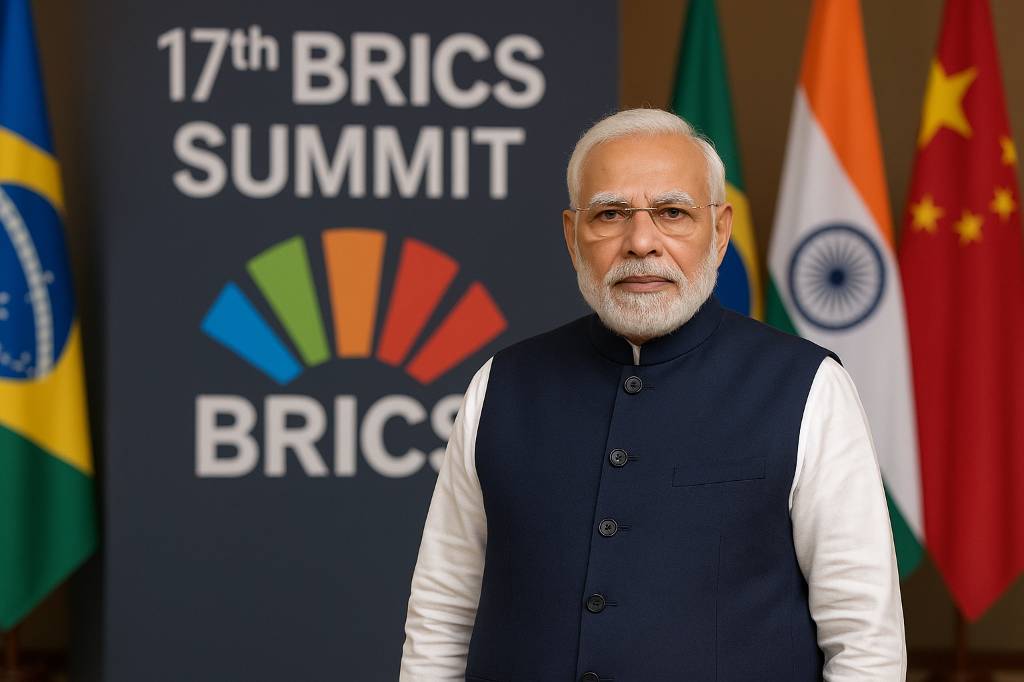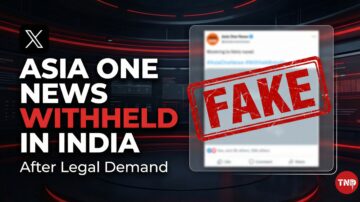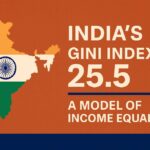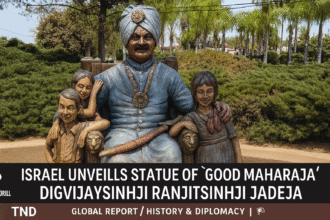
The 17th BRICS Summit in Brazil, held in Rio de Janeiro on July 6–7, 2025, marks a pivotal moment for the BRICS nations with Prime Minister Narendra Modi attending as a key leader in this influential bloc. Established in 2009 to counterbalance Western dominance, BRICS has evolved into a powerful platform of emerging economies, now expanding its membership to reflect the Global South’s interests. This article explores the summit’s highlights, what BRICS is, its objectives, member nations, and the history of PM Modi’s involvement with BRICS.
- What Is BRICS?
- BRICS Objectives and Structures
- The New Development Bank (NDB) & Contingent Reserve Arrangement
- BRICS Member Nations
- 17th BRICS Summit: Key Highlights
- PM Modi at the Summit & His BRICS Journey
- Why the 17th BRICS Summit Matters
- Challenges Facing BRICS
- PM Modi’s Role in Shaping BRICS
- Looking Ahead: Post Summit and Long Term Prospects
- Conclusion
What Is BRICS?
Origins and Founding
BRICS is an intergovernmental organization comprising Brazil, Russia, India, China, and South Africa, originally established as BRIC in 2009. The term “BRIC” was coined by economist Jim O’Neill and popularized by Goldman Sachs in 2001 to describe emerging economies projected to lead global growth. South Africa joined in 2010, formally adopting the BRICS acronym at the 2011 summit.
Expansion to BRICS+
In 2024, BRICS broadened its horizons, admitting Egypt, Ethiopia, Iran, Saudi Arabia, and the UAE. Indonesia became the latest addition in early 2025, bringing total membership to ten countries: the original five plus Egypt, Ethiopia, Iran, Saudi Arabia, the UAE, and Indonesia.
BRICS Objectives and Structures
The BRICS objectives are:
1. Reform of global institutions – pushing for fairer representation within the UN Security Council, IMF, and World Bank.
2. Economic cooperation – increasing intra-BRICS trade, foreign investment, and policy coordination.
3. De‑dollarization – promoting local currency trades and exploring alternatives to the U.S. dollar.
4. Alternative finance mechanisms – through the New Development Bank (NDB) and Contingent Reserve Arrangement (CRA).
5. Sustainable development and South‑South cooperation – financing green infrastructure and social uplift in emerging economies.
The New Development Bank (NDB) & Contingent Reserve Arrangement
New Development Bank
Launched in 2014, the NDB was branded at the Durban meeting of BRICS and began operations in 2015. Its mission is to finance infrastructure and sustainable projects across emerging economies. By 2023, the NDB approved over $39 billion across 120 ventures, including green energy and education ℎ.
Contingent Reserve Arrangement
The CRA, set up alongside the NDB in 2014, offers a financial safeguard against liquidity crises, serving as a shared liquidity pool for member nations during economic instability.
BRICS Member Nations
Original Members
- Brazil – Latin America’s largest economy, hosting the 2025 Summit.
- Russia
- India
- China
- South Africa
New Members (BRICS+)
Egypt, Ethiopia, Iran, Saudi Arabia, UAE, and Indonesia.
Collectively, these ten BRICS nations represent nearly 46% of the world’s population, over 36% of global GDP, and significant influence in oil, commodities, and innovation.
17th BRICS Summit: Key Highlights
Summit Theme & Host
The 17th BRICS Summit, under the Brazilian presidency, adopted the theme “Inclusive and Sustainable Global South”, aligning with President Lula da Silva’s vision of giving emerging economies a louder voice in global affairs.
Rio de Janeiro was confirmed as host city in February 2025, with Lula assuming the rotating chair for 2025.
Foreign Ministers’ Preparations
In late April 2025, foreign ministers met in Rio but initially failed to produce a joint statement due to disagreements on trade protectionism.
Leaders’ Summit Agenda
Scheduled for July 6–7, 2025, the summit agenda includes:
- Multilateral institution reforms (UN, IMF, WTO)
- Peace and security initiatives
- AI governance and digital cooperation
- Climate change strategies and green financing
- Global health collaboration
- Economic integration and financial mechanisms
Major Outcomes
1. Joint Leaders’ Declaration
Ahead of the summit, BRICS nations reached consensus on a joint declaration addressing the Gaza conflict, Israel–Iran tensions, and expanding African representation in the UN Security Council. The declaration also criticized U.S. protectionist trade policies.
2. IMF Reforms Proposal
BRICS Finance Ministers unified in a plan to adjust IMF quota distribution to reflect developing economies’ relative influence, considering GDP and purchasing power. They also sought to end European dominance in IMF leadership. Proposals to be tabled in December 2025.
3. Guarantee Fund via NDB
A new BRICS Multilateral Guarantee fund, under the NDB, got technical approval to de-risk private investment leveraging every dollar of guarantee to unlock $5–10 in private capital. Formal launch set for the summit.
PM Modi at the Summit & His BRICS Journey
PM Modi’s Visit
PM Narendra Modi arrived in Rio on July 6, 2025, marking his fourth visit to Brazil and concluding a multi-nation tour that included Ghana, Trinidad and Tobago, Argentina, and finally Brazil and Namibia.
In Rio, Modi is expected to:
- Address global governance and reform forums
- Propagate responsible AI, climate action, and global health
- Advance economic integration and trade among BRICS
- Hold bilateral talks with heads of fellow member countries
PM Modi and BRICS: A Historical Perspective
- 2011 Durban Summit – Modi, then Chief Minister of Gujarat, attended.
- As Prime Minister (2014–present): Modi has actively shaped BRICS priorities, advocating for terrorism countermeasures, institutional reform, and strengthened South-South cooperation.
- Modi champions India’s leadership in championing Global South democratization, aligning with NAM and Bandung Conference ideals.
PM Modi champions India’s leadership in championing Global South democratization, aligning with NAM and Bandung Conference ideals.
Why the 17th BRICS Summit Matters
Global Governance Reform
The Summit refocuses attention on UN Security Council expansion, IMF reform, and fair voting mechanisms. The IMF quota proposal is a direct outcome and milestone.
Geopolitical Shift
The bloc’s growth to ten members raises concerns about ideological balance particularly with authoritarian regimes joining but also amplifies the Global South’s voice against Western hegemony.
Financial Innovation
Through the launch of the Guarantee Fund, BRICS continues institutional evolution via the NDB, potentially accelerating sustainable infrastructure projects while reducing Western financial dependency.
Collective Political Messaging
The joint declaration on Middle East conflicts and criticism of U.S. protectionism show BRICS’s cohesion on global issues, despite increasing internal diversity.
Challenges Facing BRICS
Internal Divergences
The political and economic spectrum within BRICS is broad from democracy to authoritarianism raising challenges in aligning common positions. Recent absences by Putin (due to ICC concerns) and Xi Jinping (domestic considerations) underscore these rifts.
Expansion Strain
The bloc’s enlargement adds complexity: aligning the interests of oil rich states (Saudi, UAE, Iran) and commodity heavy economies might slow decision making.
Functional Autonomy
Despite its initiatives, BRICS still lacks a binding treaty, permanent secretariat, or legal frameworks making enforcement inconsistent.
PM Modi’s Role in Shaping BRICS
Voice for the Global South
Modi emphasizes reforming global institutions to reflect emerging economies. His speeches highlight Global South solidarity and economic justice.
Cooperation Beyond Borders
He promotes BRICS partnerships in areas like vaccine manufacturing, clean energy, and digital technology, reinforcing practical South-South cooperation.
Peace & Security
PM Modi consistently raises concerns on terrorism, promoting peaceful resolution of conflicts including Ukraine and Gaza to foster a stable multipolar order.
Looking Ahead: Post Summit and Long Term Prospects
2025–2026 Outlook
Expectations after the summit include:
December 2025: IMF quota reform tabled.
2026: First investment operations via the Guarantee Fund.
2025–26: Continued discussions on BRICS currency and de-dollarization strategies.
Strengthening Institutions
The New Development Bank will likely increase its lending capacity and regional presence, while the CRA may evolve into a more resilient financial backstop.
Global Diplomacy
BRICS is likely to use its collective influence at forums like G20, UN, and COP summits, pushing for multipolar norms and Global South leadership.
Conclusion
The 17th BRICS Summit in Brazil, with PM Modi’s active engagement, symbolizes a transformative phase. With ten diverse economies representing nearly half the world’s population, BRICS is reshaping global dynamics through economic innovation, political unity, and institutional reform. Though not without challenges in alignment and coherence, the Summit’s outcomes IMF reform plan, Guarantee Fund launch, and global diplomacy initiatives demonstrate BRICS’s commitment to its objective: creating a more equitable, inclusive, and multipolar world order for the Global South.
Stay Connected with The News Drill for more updates. Stay Ahead & Stay informed.
Contact us: contact@thenewsdrill.com
Submit a tip or story: editor@thenewsdrill.com or visit our Contributor Page.
Follow us for more updates on global summits, India’s foreign policy, and the evolving role of the Global South.







